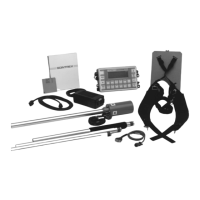Operation
A5-2 ENVI-MAG Manual
Orientation
Optimum performance can be achieved with proton magnetometers when the
axis of the sensor coils (not the sensor itself) are aligned perpendicular with the
Earth’s magnetic field. Proper orientation is of utmost importance at the
magnetic equator, where the field is horizontal. In polar regions, the field is
vertical and orientation is not as critical.
The sensors have orientation marks. Care should be taken when assembling the
gradiometer sensor to align both sensors with each other, such that the whole
assembly can be oriented in both the vertical and horizontal modes.
If the sensor is properly oriented, the sensor coil axis points east-west. This also
occurs if the sensor is mis-oriented by 180 degrees; that is the N mark points to the
south etc. This means, that a properly oriented sensor, when mounted fixed onto
the Back Plate, is suitable for surveying while walking up or down a survey line.
Effects of gradient
Many small items carried by the operator in addition to the magnetometer may
be magnetic and therefore upset, locally, the magnetic field to be measured.
Such items are notebooks, pencils, cigarette lighters, eye-glasses, dentures etc.,
just to mention a few.
The higher the magnetic gradient is at the sensor, the poorer the proton
precession magnetometers operate, since the precession signal decays more
rapidly. With an abrupt signal decay at very high gradients, measurements are
impossible to obtain. Also, the closer a sensor is to a highly magnetic object, the
higher the gradient the higher the gradient that will be present at the sensor.
Display page 2 of the Numeric Data display (page A3-31) shows a bar graph
indicating the decay and the average signal amplitude. It is good practice to get
familiar with this feature as it is a useful tool in diagnosing difficulties.
-*MAG*- hh:mm:ss
TOTAL GRADIENT LN:llllld
mmmmm.m ggggg.g ST:sssssd
mmmmm.m ggggg.g sssssd
mmmmm.m ggggg.g sssssd
mmmmm.m ggggg.g sssssd
MEMF: nn%
BATT: bbb

